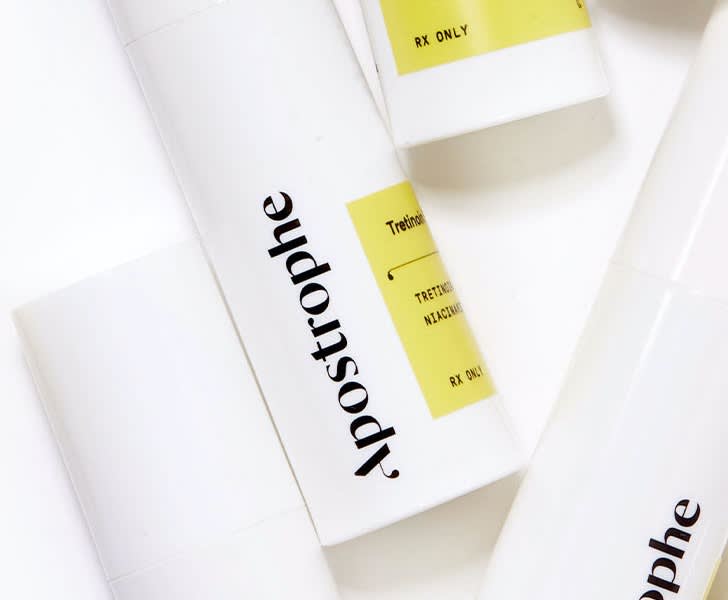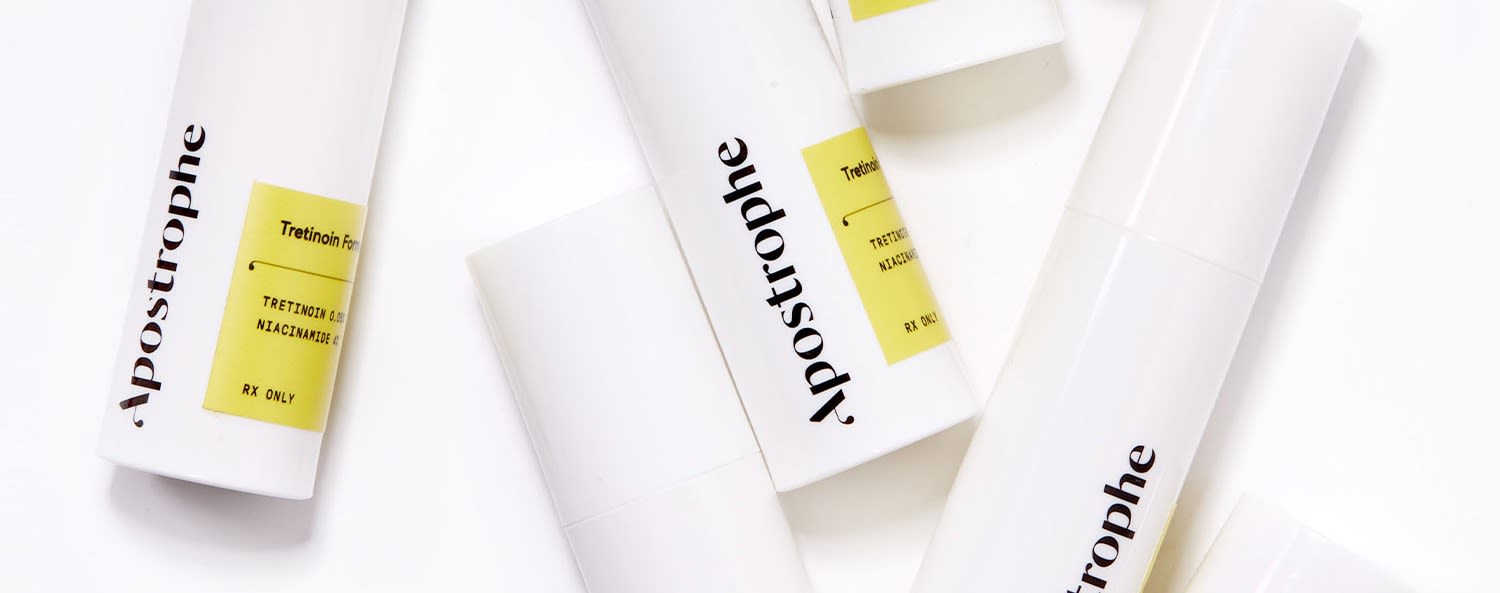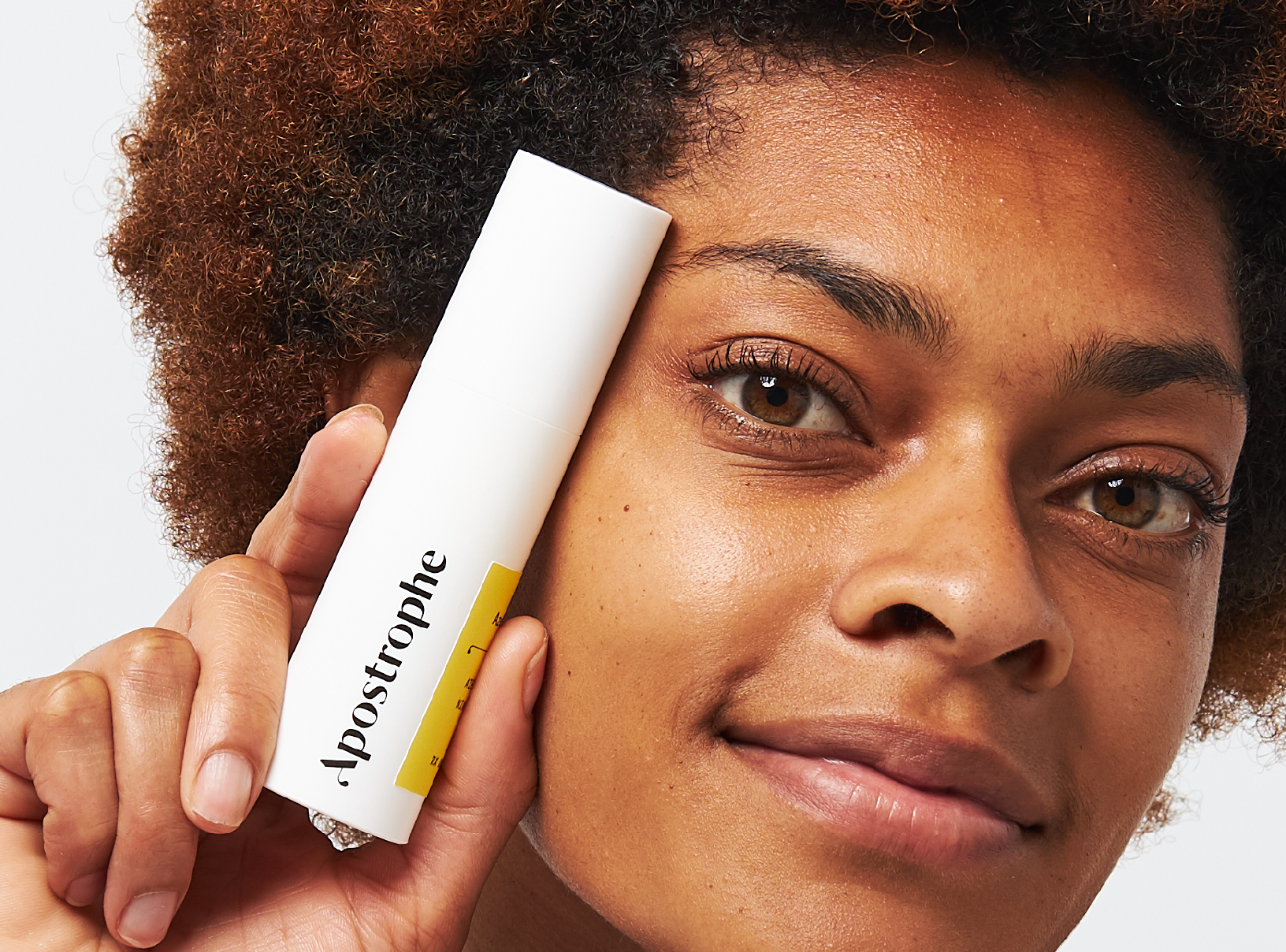Education
Can you use niacinamide and retinol together?


SHARE
Education
Can you use niacinamide and retinol together?
Medically reviewed by Kristin Hall, FNP
Written by Apostrophe Team
Last updated 10/1/2024
Your skin does a lot for you, from keeping your vital organs safe, to protecting the rest of your body from the elements, to cooling you down when it’s hot outside. For a lot of people, the skin is also a canvas for personal expression.
Your skin may also have issues you want to address, like wrinkles and acne. To protect your multi-use skin from these skin concerns, you may need multiple types of skin treatment.
Niacinamide and retinol are two powerful tools in the skin health utility belt, especially if you have acne-prone skin. If you’re curious about using them together, there are some things for you to know.
Retinol and niacinamide are two vitamin derivatives that can greatly benefit skin health, and their key ingredients can promote moisture and protect your skin from aging and acne alike.
Before we discuss how you can safely use them together, we need to go over some basics. Let’s start with a simple question.
What Causes Acne?
Simply put, acne is when your pore gets clogged, resulting from an imbalance in key elements of skin health. The four factors that can contribute to pimples are dead skin cells, hydration, oil production, and bacteria.
Imbalances lead to snowballing problems. Blemishes occur when your dead cells accumulate in pores, triggering an excess production of sebum to help them slide out.
If this works the way it should, your skin stays healthy, but between the extra oil and the dry skin cells, your pore can become a perfect breeding ground for acne bacteria. When that happens, bacteria can thrive, leading to inflammation and painful pimples.
Acne can occur for a variety of reasons; diet, stress, the weather, hydration issues, and genetics can all contribute to your odds of having acne problems.
At the end of the day, however, a lot of it comes down to hormones.
What Causes Wrinkles
Like acne, wrinkles are often caused by a complex collection of factors, but many of them have to do with one central issue: short- or long-term damage to the structures that make up your skin.
This kind of skin damage can come at you from many directions, but most of those reasons have to do with stress to the biomechanics that nourish and heal your skin.
External factors — from the sun and air quality to your diet and sleeping position — can also play a large role in your skin’s aging.
We all know that long-term sun exposure (specifically to ultraviolet light or UV rays) can give you wrinkles, but other chronic issues like poor nutrition, smoking, insufficient hydration, and basic things like sleeping face down on your pillow can contribute to damage — especially if you’re not regularly using a broad-spectrum sunscreen.
There are two major theories of skin aging. They each point to one of the two primary mechanisms for the appearance of wrinkles: either intrinsic sources, like the decrease of function and reduced cellular lifespan over time; and extrinsic factors, i.e. damage, inflammation, and the formation of free radicals.
These theories have names: the Programmatic Theory focuses on intrinsic factors, and the Stochastic Theory points to extrinsic sources. Both have their merits and you should consider them together when looking at ways to prevent and/or deal with wrinkles.
Retinoids: The Basics
So how do we treat wrinkles and acne? One answer might be retinoids.
Retinoids go by several names, including retinol, retinoids, retin-A® compounds, or vitamin A.
They’re all chemical exfoliants, and in topical application, all retinoids do two things: they help remove the dead skin cell layer on top of your skin (which contributes to acne problems and can also make you look wrinkly), and they stimulate the production of new cellular growth beneath that layer.
The result of this is two benefits: the layer of older, dead skin is removed, and younger skin underneath it gets a boost for growth.
When it comes to acne, this combination of benefits can help your struggling pores shed those dried out cells and move along to the newer stuff.
And when it comes to skin aging, speeding up your skin’s cell turnover process helps to flatten the appearance of wrinkles, while also evening out your uneven skin tone.
There are over-the-counter options in the retinoid world, but prescription options are also available for the more difficult cases. One of the most popularly prescribed retinoids is tretinoin, which is a powerful version of Vitamin A.

PRESCRIPTION TRETINOIN
Target acne, dark spots, and signs of aging with this science-backed ingredient.
While the skin benefits of tretinoin may be obvious, there are warnings you should heed for side effects.
Retinoids have a tendency to cause irritation of the skin, and they can also exacerbate existing irritations, which means they’re not necessarily the best treatment option if your acne is inflamed.
Of the potential side effects that we know of for retinoids like tretinoin, you should look for redness and peeling — usually temporary side effects that are known affectionately as the Tretinoin Purge.
And many of these problems can be compounded for people with sensitive skin types, so it’s important to mention your sensitive skin to your healthcare provider if you have those issues, before starting a course of retinoid treatment.
How to Properly Use Topical Retinoids For Acne
Because retinoids can be used effectively or ineffectively, we’ve made a brief list of things you should know before starting a retinol regimen.
Topical retinoids, for example, are best used in the evening, because sunlight can lessen their effects. Tretinoin is a volatile chemical, known to break down and become ineffective when exposed to sunlight.
Retinoids can also become more effective for anti-aging benefits when combined with vitamin C, which is an antioxidant for your skin, and the combination can protect it from free radicals and other skin stressors throughout the day.
There are also antibiotics that you can take alongside retinoids. Clindamycin is typically prescribed to treat infections of major organs like the lungs, skin, and reproductive system, but is also used to inhibit the growth of bacteria that cause acne, while simultaneously reducing inflammation.
For acne, clindamycin has been shown to slow bacteria's spread and growth, and it may prevent them from multiplying entirely.
You may end up using one or all of these medications in tandem, based on the advice of your healthcare provider for your individual issues.
Niacinamide: The Basics
Despite its complicated name, niacinamide is simply a form of vitamin B3, alongside niacin. It occurs naturally in foods including fish, milk, eggs, beans, cereal grains, yeast, meat, and green vegetables.
Primarily, niacinamide is prescribed for treating B3 vitamin deficiencies and related skin conditions such as pellagra.
The National Library of Medicine also lists other conditions that niacinamide is used to treat, including acne, diabetes, osteoarthritis, and even certain cancers. However, this is contextualized with the slightly less optimistic “possibly effective for” notation.
Niacinamide is required by the body for proper function of fats and sugars, which are essential for the functions of cells and organs alike.
Niacinamide Side Effects
When taken orally (and in the recommended doses), niacinamide is considered mostly safe, though the risk of overdose (a typical adult should take no more than 35mg of niacinamide daily) may cause liver problems or result in high blood sugar.
As a topical ingredient, niacinamide can cause itching, burning, or redness in some cases.
When taken orally, side effects of niacinamide can include upset stomach, gas, and dizziness, as well as other issues.
Serious side effects may also include worsening of allergic reactions or diabetes issues and kidney and liver diseases.
How to Use Niacinamide for Acne
As we discussed above, acne is the result of a bacterial infection, which happens inside the pores. It’s a problem-causing imbalance between normally occurring, like bacteria, moisture, oil, and dead skin cells.
Our guide to the Types of Acne offers more detailed information, but in short, fighting acne is about helping your skin return to balance, which is something niacinamide could help with.
The specific mechanism for how niacinamide helps fight acne is not yet fully understood, but there are some theories (and results from trials).
Niacinamide has shown efficacy in some clinical trials for treating skin issues like acne and aging.
One clinical trial showed it was effective in reducing red splotches, spots, fine lines, hyperpigmentation, and wrinkles in white females.
Another study found that a 2% topical gel utilizing niacinamide slowed the rate of sebum (oil) excretion, which can in turn reduce oiliness and certain types of acne.
It’s worth noting, however, that niacinamide’s effectiveness in this study was also related to environmental factors, and that the effectiveness varied depending on race.
There are other potential benefits, though. Another study of niacinamide showed that a topical application can even keep your skin hydrated by stabilizing the skin’s barrier, which makes niacinamide potentially valuable as a cosmetics ingredient.
Additional research shows that niacinamide can even increase skin permeability, which may help with moisture retention and also reduce both scarring and wrinkles.
However, it’s worth noting that many of these studies of niacinamide and acne are at least 10 years old (or more) — and few of them have been effectively recreated or further explored in that time.
The bottom line: niacinamide holds potential both as an effective acne fighting ingredient and as an anti-aging agent, but further study is definitely needed before either is touted as a miracle cure.
Using Retinol and Niacinamide Together
Not only is using retinol and niacinamide together safe, it’s also effective. Studies show that using the two in conjunction shows significant improvement over time.
One study, for instance, found that a combination treatment reduced fine lines after just two weeks.
After four weeks, the same combination reduced hyperpigmentation, improved overall skin clarity and evenness, and reduced wrinkles.
There were mild symptoms associated with retinol, but those had largely vanished among test subjects by week ten.
Another study found that there may be a proper order in which to use niacinamide and retinol.
Using niacinamide first was found to help the skin create a more effective barrier against the irritating side effects of retinol.
This benefit from using niacinamide has been attributed to its ability to help the skin retain moisture. Moisture retention helps to reduce the side effects while augmenting the benefits of the treatment.
Niacinamide and Retinol: Final Thoughts
As acne-combating tools go, topical retinoids are a proven safe and effective option, but they have their limits.
Known side effects aside, they also need to be used carefully (and as instructed), and may cause conflicts with other medications and treatments.
Niacinamide, on the other hand, has been shown in studies to improve skin health, fight acne, and combat the signs of aging — all with a mild profile of side effects.
We don’t know everything about either medication, but we know that these two drugs work well together.
If you’re looking to keep your skin looking and feeling its best, the first step should be consulting a dermatology provider about what your options are. When you have that conversation, don’t hesitate to ask if retinol and niacinamide should be a part of your daily skincare routine.
References:
Rodan, K., Fields, K., Majewski, G., & Falla, T. (2016). Skincare Bootcamp: The Evolving Role of Skincare. Plastic and reconstructive surgery. Global open, 4(12 Suppl Anatomy and Safety in Cosmetic Medicine: Cosmetic Bootcamp), e1152. https://www.ncbi.nlm.nih.gov/pmc/articles/PMC5172479/.
Jegasothy, S. M., Zabolotniaia, V., & Bielfeldt, S. (2014). Efficacy of a New Topical Nano-hyaluronic Acid in Humans. The Journal of clinical and aesthetic dermatology, 7(3), 27–29. Retrieved from https://www.ncbi.nlm.nih.gov/pmc/articles/PMC3970829/.
Tanno, O., Ota, Y., Kitamura, N., Katsube, T., & Inoue, S. (2000). Nicotinamide increases biosynthesis of ceramides as well as other stratum corneum lipids to improve the epidermal permeability barrier. The British journal of dermatology, 143(3), 524–531. https://pubmed.ncbi.nlm.nih.gov/10971324/.
Gehring, W. (2004), Nicotinic acid/niacinamide and the skin. Journal of Cosmetic Dermatology, 3: 88-93. https://onlinelibrary.wiley.com/doi/abs/10.1111/j.1473-2130.2004.00115.x.
Bissett, D. L., Oblong, J. E., & Berge, C. A. (2005). Niacinamide: A B vitamin that improves aging facial skin appearance. Dermatologic surgery : official publication for American Society for Dermatologic Surgery [et al.], 31(7 Pt 2), 860–865. https://doi.org/10.1111/j.1524-4725.2005.31732.
Zoe Diana Draelos, Akira Matsubara & Kenneth Smiles (2006) The effect of 2% niacinamide on facial sebum production, Journal of Cosmetic and Laser Therapy, 8:2, 96-101, https://www.tandfonline.com/action/showCitFormats?doi=10.1080%2F14764170600717704.
U.S. National Library of Medicine. (n.d.). Niacinamide: MedlinePlus Supplements. MedlinePlus. https://medlineplus.gov/druginfo/natural/1534.html.
Fox, L., Csongradi, C., Aucamp, M., du Plessis, J., & Gerber, M. (2016). Treatment Modalities for Acne. Molecules (Basel, Switzerland), 21(8), 1063. https://www.ncbi.nlm.nih.gov/pmc/articles/PMC6273829/.
Rathi S. K. (2011). Acne vulgaris treatment : the current scenario. Indian journal of dermatology, 56(1), 7–13. https://www.ncbi.nlm.nih.gov/pmc/articles/PMC3088940/.
Clindamycin: Medlineplus drug information. (n.d.). Retrieved May 01, 2021, from https://medlineplus.gov/druginfo/meds/a682399.html.
Telang P. S. (2013). Vitamin C in dermatology. Indian dermatology online journal, 4(2), 143–146. https://www.ncbi.nlm.nih.gov/pmc/articles/PMC3673383/#:~:text=Vitamin%20C%20is%20a%20potent,for%20the%20treatment%20of%20hyperpigmentation.
Retinoids. (2020). In LiverTox: Clinical and Research Information on Drug-Induced Liver Injury. National Institute of Diabetes and Digestive and Kidney Diseases. https://pubmed.ncbi.nlm.nih.gov/31643883/.
Yoham AL, Casadesus D. Tretinoin. [Updated 2020 Dec 5]. In: StatPearls [Internet]. Treasure Island (FL): StatPearls Publishing; 2021 Jan-. Available from: https://www.ncbi.nlm.nih.gov/books/NBK557478/.
Jegasothy, S. M., Zabolotniaia, V., & Bielfeldt, S. (2014). Efficacy of a New Topical Nano-hyaluronic Acid in Humans. The Journal of clinical and aesthetic dermatology, 7(3), 27–29. Retrieved from https://www.ncbi.nlm.nih.gov/pmc/articles/PMC3970829/.
American Academy of Dermatology Association. (n.d.). CAN THE RIGHT DIET GET RID OF ACNE? Retrieved March 5, 2021, from https://www.aad.org/public/diseases/acne/causes/diet.
Acne. (n.d.). Retrieved January 28, 2021, from https://www.hopkinsmedicine.org/health/conditions-and-diseases/acne.
Jović A, Marinović B, Kostović K, Čeović R, Basta-Juzbašić A, Bukvić Mokos Z. The Impact of Pyschological Stress on Acne. Acta Dermatovenerol Croat. 2017 Jul;25(2):1133-141. PMID: 28871928. Retrieved from: https://pubmed.ncbi.nlm.nih.gov/28871928
Palma, L., Marques, L. T., Bujan, J., & Rodrigues, L. M. (2015). Dietary water affects human skin hydration and biomechanics. Clinical, cosmetic and investigational dermatology, 8, 413–421. Retrieved from https://www.ncbi.nlm.nih.gov/pmc/articles/PMC4529263/
Pappas A. (2009). The relationship of diet and acne: A review. Dermato-endocrinology, 1(5), 262–267. Retrieved from https://www.ncbi.nlm.nih.gov/pmc/articles/PMC2836431/.
Song, X., xu, A., Pan, W., Wallin, B., Kivlin, R., Lu, S. ... Wan, Y. (2008). Nicotinamide attenuates aquaporin 3 overexpression induced by retinoic acid through inhibition of EGFR/ERK in cultured human skin keratinocytes. International Journal of Molecular Medicine, 22, 229-236. https://www.spandidos-publications.com/ijmm/22/2/229.
Farris, P., Zeichner, J., & Berson, D. (2016). Efficacy and Tolerability of a Skin Brightening/Anti-Aging Cosmeceutical Containing Retinol 0.5%, Niacinamide, Hexylresorcinol, and Resveratrol. Journal of drugs in dermatology : JDD, 15(7), 863–868. https://pubmed.ncbi.nlm.nih.gov/27391637/.
Draelos, Z. D., Ertel, K. D., & Berge, C. A. (2006). Facilitating facial retinization through barrier improvement. Cutis, 78(4), 275–281. https://pubmed.ncbi.nlm.nih.gov/17121065/.
Like what you just read? Sign up for our email list to get the scoop on skincare science delivered straight to your inbox.

Deep Dives
A dermatologist shares his thoughts on the recent studies about benzoyl peroxide and benzene.
Read More
Education
What is milia?
What is milia? Today, we’re jumping into one type of bump that you may have heard about most commonly in infants — milia.
Read More
Education
Best moisturizer for acne-prone skin
If you have combination acne-prone skin, figuring out which moisturizer is best for your skin might be tough. In this guide, we break down the best moisturizer for combination, acne-prone skin.
Read More

